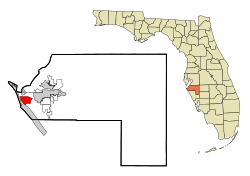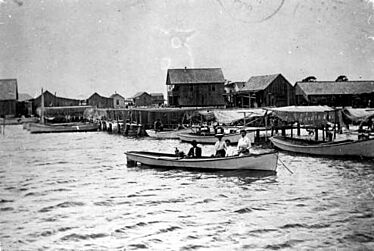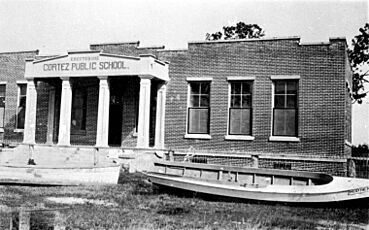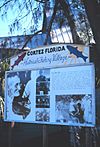Cortez, Florida facts for kids
Quick facts for kids
Cortez, Florida
|
|
|---|---|

Location in Manatee County and the state of Florida
|
|
| Country | |
| State | |
| County | Manatee |
| Area | |
| • Total | 5.11 sq mi (13.24 km2) |
| • Land | 2.23 sq mi (5.78 km2) |
| • Water | 2.88 sq mi (7.46 km2) |
| Elevation | 3 ft (1 m) |
| Population
(2020)
|
|
| • Total | 4,121 |
| • Density | 1,847.15/sq mi (713.24/km2) |
| Time zone | UTC-5 (Eastern (EST)) |
| • Summer (DST) | UTC-4 (EDT) |
| ZIP codes |
34215 (Cortez)
34210 (Bradenton) |
| Area code(s) | 941 |
| FIPS code | 12-14700 |
| GNIS feature ID | 0280867 |
Cortez is a small fishing village on the Gulf Coast of Florida, located in Manatee County, Florida. It's known as a census-designated place (CDP), which means it's a community identified by the U.S. Census Bureau for statistical purposes, but it's not an officially incorporated city or town. Settlers from North Carolina founded Cortez in the 1880s. In 2020, about 4,121 people lived there. Cortez is part of the larger North Port-Bradenton-Sarasota metropolitan area.
Contents
History of Cortez
Early Days of Cortez
Ancient People in the Area
Long ago, from about 900 CE to the 1700s, the area where Cortez is now was home to the Safety Harbor culture people. They built villages and lived along the shores of Tampa Bay and the nearby Gulf of Mexico. We know about them because of special pottery found in their burial mounds. Sadly, these people mostly disappeared due to diseases and conflicts with other Native American groups.
The Calusa people, also called the "Shell Indians," lived along Florida's southwest coast. Spanish explorers first wrote about them in 1513. The Calusa became very powerful in the Tampa Bay area after the Safety Harbor culture faded. They are thought to have stayed until 1763, when the remaining Calusa, whose numbers had shrunk from disease and wars, moved to Cuba.
How the Calusa Lived
The Calusa people were amazing fishermen. They made nets from palm tree fibers to catch fish like mullet and catfish. They also used spears with arrowheads made from fish teeth and spines to hunt eels and turtles. Women and children collected shellfish like crabs, lobsters, oysters, and clams. They used these shells to create tools, utensils, ornaments, weapons, and jewelry. The Calusa people eventually declined because of diseases brought by European explorers and attacks from other tribes.
Cuban Fishermen Arrive
Around the mid-1700s, Cuban fishermen started traveling north to fish in the waters off Florida's Gulf Coast. They set up temporary camps called ranchos, where they stayed for about six months. They would dry and salt their catches to take back to Cuba to sell, especially before Lent when fish was in high demand. The Florida waters were very appealing because they were full of fish and didn't have many permanent settlements yet. This area was perfect for their preferred method of inshore net fishing.
Founding and the 1800s
Cortez was first called "Hunter's Point." Families from Carteret County, North Carolina settled here in the 1880s. When a post office opened in 1888, the village needed a new name to avoid confusion with another Hunter's Point in Florida. The name "Cortez" might have come from the Spanish explorer Hernán Cortés, though this isn't officially proven. In its early days, Cortez was a very rural fishing village, often reached by boat rather than by land. Fishing has always been, and still is, a very important industry for Cortez.
The First Store: The Bratton/Burton Store
The first business building in Cortez was built by William C. Bratton in the 1890s. This store helped connect Cortez to the outside world. It housed the post office, a general store, and a steamboat dock. Later, rooms were added to turn it into the Albion Inn. The Albion Inn and the 1912 schoolhouse were some of the only buildings on the waterfront to survive the powerful 1921 Tampa Bay hurricane. The Inn eventually closed and was sold to the U.S. Coast Guard. It served as U.S. Coast Guard Station Cortez from 1974 to 1991. When it was planned for demolition, Cortez residents worked together to save the original Bratton/Burton Store part of the building. In 2006, it was moved to the grounds of the Florida Maritime Museum.
Cortez in the 1900s
The 1912 Schoolhouse
Before 1912, children in Cortez went to a small, one-room wooden schoolhouse. In 1912, a larger brick school, called the Cortez Rural Graded Schoolhouse, replaced it. The Cortez Mother's Club played a big role in building and supporting this new school. The building became a central place for the community and offered shelter during the 1921 Tampa Bay hurricane. It first had three classrooms, and in 1933, one was made bigger to become an auditorium. This building was used as a school until 1961. After that, it was an art school and then the home and studio of a weaver named Robert Sailors. After he passed away, Manatee County bought the schoolhouse and started restoring it in 1999. In 2006, it reopened as a museum. Today, the Cortez Rural Graded Schoolhouse is home to the Florida Maritime Museum.
World War I and II
When the United States entered World War I in 1917, many Cortez residents served. Ten residents are known to have joined, mostly in the US Army and US Navy.
World War II also had a big impact on Cortez. Most men went to war, often joining the U.S. Navy or Coast Guard because sailing was part of their lives. Many women also served as nurses. Those who stayed behind worked hard to keep Cortez and its fishing industry going. Fishing had always been a family business, but with so many young men and women gone, workers were hired from outside families. Women and young girls started working and fishing for 75 cents an hour to support their families and fill in for the men.
Building the Cortez Bridge
Work on the Cortez Bridge, which connects Anna Maria Island to Cortez, started in 1921. Before this, Anna Maria Island could only be reached by boat. Construction stopped after the 1921 Tampa Bay hurricane destroyed the progress. In 1922, building started again, and the wooden bridge was finished. This wooden bridge connected Cortez Road to Bridge Street in Bradenton Beach. In the 1950s, a new concrete bridge replaced the wooden one. To show how strong the new bridge was, elephants from Ringling Circus were paraded across it!
The Hurricane of 1921
In October 1921, Cortez was hit by a powerful hurricane, estimated to be a Category 3 or 4 storm. People in Cortez had little warning and took shelter in the 1912 Rural Graded Schoolhouse. The hurricane almost completely destroyed the waterfront, leaving few buildings standing. The waterfront had to be rebuilt and looks very different today from how it once did.
The Roaring Twenties and Great Depression
The 1920s brought many changes to Cortez. For the first time, seafood was delivered by road as residents started owning cars. Electricity also became common, making many tasks easier.
During the Great Depression, Cortez was one of the few communities in the United States that did not receive federal aid.
Geography of Cortez
Cortez is located in western Manatee County. The village sits at the west end of a peninsula, with Anna Maria Sound to the west, Palma Sola Bay to the north, and Sarasota Bay to the south. The Cortez area, as defined by the census, includes the village and the rest of the peninsula to the east.
Florida State Road 684 is the main road through Cortez. It goes east about 7 miles (11 km) to South Bradenton and west across Anna Maria Sound to Bradenton Beach.
Cortez covers about 5.1 square miles (13.2 square kilometers) in total. About 2.2 square miles (5.7 square kilometers) is land, and 2.9 square miles (7.5 square kilometers), or 56.37%, is water. Cortez is in a safe harbor, protected from strong winds by Anna Maria Island and Longboat Key, which are Florida's barrier islands.
People of Cortez
| Historical population | |||
|---|---|---|---|
| Census | Pop. | %± | |
| 1980 | 3,821 | — | |
| 1990 | 4,509 | 18.0% | |
| 2000 | 4,491 | −0.4% | |
| 2010 | 4,241 | −5.6% | |
| 2020 | 4,121 | −2.8% | |
| Sources: | |||
In 2020, the population of Cortez was 4,121 people. The community has a mix of residents, with a notable number of people aged 65 or older.
Museums and Culture in Cortez
Cortez Historic District
The Cortez Historic District is a special area in Cortez that was recognized as a U.S. historic district on March 16, 1995. It's bounded by Cortez Road, 119th Street W, Sarasota Bay, and 124th Street Court W. This district helps protect the old buildings and feel of the historic village.
Cortez Cultural Center
The Cortez Cultural Center works to preserve the history of "old Florida" and the stories of the founding families in Cortez. The center's exhibits cover Cortez's history from its founding up to the 1980s, with plans to eventually include more recent history.
Florida Institute of Saltwater Heritage (F.I.S.H.)
The Florida Institute for Saltwater Heritage (F.I.S.H.) is a non-profit group started in 1991. F.I.S.H. is working to restore over 100 acres (40 hectares) of important natural land on Sarasota Bay. Every year, F.I.S.H. and Cortez host a Commercial Fishing Festival during the third weekend of February, which thousands of people attend.
Florida Maritime Museum
The Florida Maritime Museum (FMM) is a museum located on 4 acres (1.6 hectares) of land within the historic fishing village of Cortez. The museum tells many stories about Florida's maritime history, which means history related to the sea and boats. Its exhibits include old photographs, boat models, tools, instruments, seashells, and other historical items.
The museum also has a folk school that teaches traditional Florida skills and a research library. The library has many books, plans, logs, diaries, and other materials related to maritime subjects, especially about Florida's Gulf Coast. The museum is housed in the 1912 schoolhouse building, which is part of the 95-acre (38 hectare) Cortez Nature Preserve. Other historic buildings on the site include the 1890 Burton Store, a wooden cistern, and the Pillsbury Boat Shop.
Images for kids
See also
 In Spanish: Cortez (Florida) para niños
In Spanish: Cortez (Florida) para niños






